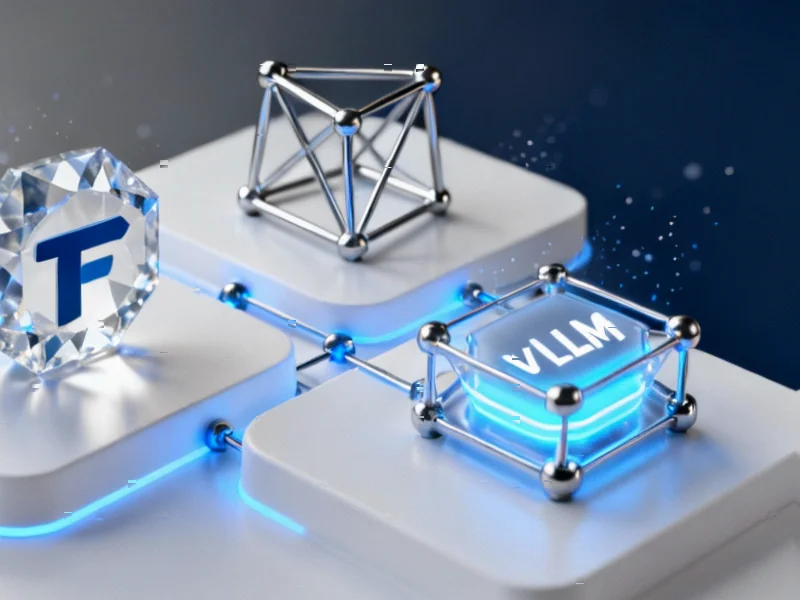Major Consolidation in AI Infrastructure
The PyTorch Foundation has expanded its portfolio by adopting Ray, the distributed computing framework originally developed by Anyscale, according to industry reports. This strategic move unites three critical AI infrastructure components—PyTorch for training, vLLM for inference, and Ray for distributed computing—under a single governance model managed by the Linux Foundation.
Table of Contents
Addressing Enterprise Vendor Concerns
Organizations building AI infrastructure face substantial risks when core technologies remain under single-company control, analysts suggest. The report indicates that vendor priorities can shift through acquisitions, funding pressures or strategic pivots, leaving dependent enterprises with limited recourse. By transferring Ray to foundation governance, sources indicate that Anyscale no longer controls the project’s development roadmap, security practices or licensing decisions.
The PyTorch Foundation’s governance structure reportedly separates technical and business decision-making, preventing any single company from unilaterally changing project direction. A Technical Advisory Council comprising individuals from multiple organizations manages technical direction, while a Governing Board with representatives from AMD, AWS, Google, Meta, Microsoft and NVIDIA handles business decisions.
Creating Unified AI Development Stack
Enterprises typically assemble AI infrastructure from disparate tools for data processing, training and serving, creating integration challenges and complicating troubleshooting, according to the analysis. The PyTorch Foundation’s expanded portfolio now covers three critical layers that can coordinate on interoperability without negotiating between competing vendors.
Ray addresses computational demands that PyTorch and vLLM cannot handle alone, the report states. It scales data processing for multimodal datasets including text, images and video, distributes training workloads across thousands of GPUs, and orchestrates inference serving with dynamic resource allocation. Organizations can now source these capabilities from a single foundation rather than assembling them from multiple commercial providers.
Long-term Infrastructure Stability
Technology leaders making infrastructure decisions must account for five to ten-year horizons, according to industry experts. Commercial vendors may alter pricing, deprecate features or pivot to different markets, while foundation-hosted projects offer stability through distributed ownership and transparent governance.
The Linux Foundation has sustained major infrastructure projects including Kubernetes for over a decade by providing legal frameworks, neutral trademark management and operational support. Projects under foundation governance reportedly publish roadmaps publicly, conduct technical discussions in open forums and maintain clear processes for community participation., according to recent developments
Enhanced Collaboration Opportunities
Before foundation hosting, improvements to distributed computing often required coordination between Ray’s developers at Anyscale and teams building complementary tools at separate organizations, creating delays as companies negotiated sharing proprietary optimizations. Under PyTorch Foundation governance, contributors from Google, Meta, Microsoft and other organizations can collaborate directly on shared infrastructure challenges without commercial negotiations.
The foundation model also reduces redundant development, according to the analysis. Multiple companies were building similar distributed computing capabilities because commercial alternatives carried vendor lock-in risks. With Ray under neutral governance, organizations can contribute improvements to shared infrastructure rather than maintaining parallel implementations.
Commercial Ecosystem Development
Anyscale continues operating as a commercial entity offering managed Ray services with enhanced performance and enterprise features, according to reports. The company’s platform provides optimized runtimes, governance tools and support that extend beyond the open source project.
This separation between open source development and commercial offerings mirrors successful models from companies building businesses on foundation-hosted projects. Anyscale can compete on service quality and integration capabilities while contributing to shared infrastructure that benefits the broader ecosystem.
For enterprises, this arrangement provides deployment options. Organizations with distributed systems expertise can deploy foundation-governed Ray directly, while those preferring managed services can purchase from Anyscale or cloud providers offering Ray integration. The neutral foundation ensures these commercial offerings remain interoperable with the core project.
Competitive Positioning Against Cloud Giants
The consolidation under PyTorch Foundation positions the combined stack against proprietary alternatives from major cloud providers, according to industry observers. Organizations concerned about platform lock-in now have a vendor-neutral option covering the full AI lifecycle from data processing through production deployment.
Ray has accumulated over 237 million downloads and powers AI infrastructure at companies including OpenAI, Uber, Shopify and Netflix. The framework originated at UC Berkeley’s RISELab before being commercialized by Anyscale. More information about the PyTorch Foundation’s governance structure is available through their official website.
Related Articles You May Find Interesting
- California Enacts Sweeping AI and Social Media Safety Legislation
- Revolutionary Solar-Powered Retinal Implant Enables Blind Patients to Read Again
- mRNA COVID Vaccination During Cancer Treatment Associated With Dramatic Survival
- Data Center Startup Achieves Rapid AI Deployment Using Brownfield Strategy
- Boeing Strikers to Vote on Revised Contract Offer After 80-Day Walkout
References
- https://pytorch.org/foundation/
- https://www.ray.io/
- https://pytorch.org/
- https://docs.vllm.ai/en/stable/
- https://www.anyscale.com/
- https://rise.cs.berkeley.edu/
- http://en.wikipedia.org/wiki/PyTorch
- http://en.wikipedia.org/wiki/Distributed_computing
- http://en.wikipedia.org/wiki/Statistical_inference
- http://en.wikipedia.org/wiki/Data_processing
- http://en.wikipedia.org/wiki/Artificial_intelligence
This article aggregates information from publicly available sources. All trademarks and copyrights belong to their respective owners.
Note: Featured image is for illustrative purposes only and does not represent any specific product, service, or entity mentioned in this article.



